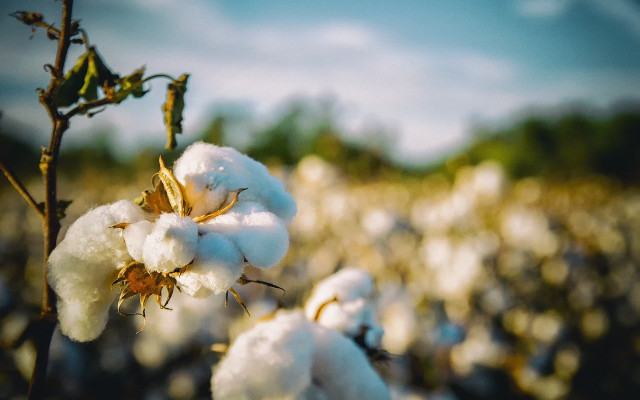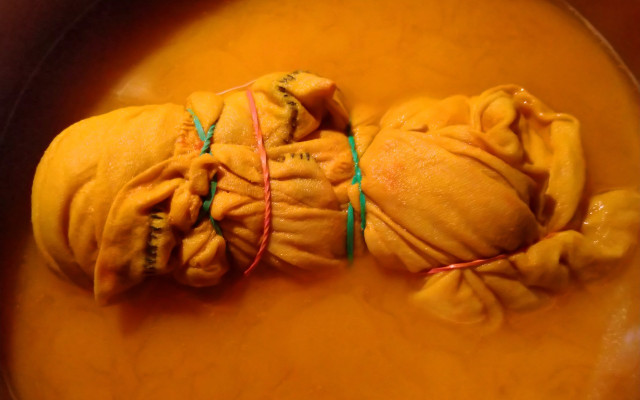Bored at home? Got a bunch of ratty old T-shirts? Instead of throwing them away, why not learn how to make tie-dye shirts? Follow these step-by-step tie-dye instructions to learn how to tie-dye T-shirts with all-natural dye.
Tie-dye is a term invented by Americans in the 1960’s to refer to a set of ancient dyeing techniques. We’ll show you how to make tie-dye shirts using turmeric as a dye, to give new life to old clothes.
Origins of Tie-Dye
In the United Staes, “tie-dye” is used to refer to a variety of resist-dyeing techniques that have been developed and used by Asian, African, and South American cultures for centuries. One such technique, called Batik (“painted” in Javanese) originates in Indonesia. Patterns are drawn by hand in liquid wax using a pen-like tool called a Tjanting on the fabric (cotton, linen, silk etc.). The places where the wax has been applied will not absorb any color when the material is submerged in dye.
For our purposes of tie-dying a T-shirt, we’ll be sticking to the more simple tie-dye instructions: We’ll be using the rubber-band method that you probably used at least once back in grade school.
Looking for more fun projects for kids? Try these simple bubble recipes or learn how to make homemade playdough!
How to Make Tie-Dye Shirts: Choosing a Fabric

The first step in learning how to tie-dye T-shirts is deciding what material to use. To get the best results, you’ll want fabric that is made of natural fibers:
- Cotton
- Hemp
- Linen
- Viscose, also called rayon
- Silk (the color will fade a bit in the process)
If you try to use a mixed fabric containing synthetic fibers, the synthetic part will stay white or absorb only very little color. This is often most obvious at the seams. Pure polyester cannot be colored using natural dyes.
If you’ve got some old T-shirts that you’re thinking about getting rid of and you’re not sure what material they’re made of, feel free to experiment with anyway. If it works out, you’ve got a cool, handmade tie-dye T-shirt. If not, you can use them as rags.
Tie-Dye Instructions: Preparation



Before you begin making your tie-dye shirt, you’ll need the following things:
- T-shirt
- Water
- Large pot for the dye bath
- Wooden/metal stirring spoon
- Barbecue tongs to put in and take out of the dye bath
- Several rubber bands or strings
- 2 to 5 tablespoons turmeric, depending on the size of your shirt
- Dishwashing gloves, if you want to avoid staining your fingers
How To Tie-Dye T-Shirts: Dyeing



Ready to make your tie-dye shirt? Here are our easy tie-dye instructions using natural turmeric dye:
- Take your white shirt, washed without fabric softener, and tie or twist it according to your desired tie-dye pattern, using rubber bands or strings.
- Fill your large pot with hot water.
- Add your turmeric powder, using more or less depending on the size of your T-shirt and the amount of water in your pot.
- Put the T-shirt into the pot with the tongs and let it steep for several hours or overnight. Leave the T-shirt in the pot for a shorter or longer time depending on your desired color intensity. For an even result, rotate the shirt from time to time.
- When you’re satisfied that your tie-dye shirt is done, take it out of the pot with tongs, remove the rubber bands, and rinse under cold water until the water runs clear. It results in a wonderful bright yellow.
- Finally, hang your T-shirt on a hanger to dry.
- To set the color, rinse in vinegar water and iron.
- When it’s time to wash your T-shirt, wash it either by hand or with similar colors in the washing machine.
Read on: Washing Clothes with Vinegar: Benefits of Adding Vinegar to Laundry
How to Make Tie-Dye Shirts with Other Natural Dyes
There are so many plants that can be used to make natural dye. Why use chemicals? Try replacing the turmeric in our tie-dye instructions with one of these plants, to get a different color:
- Pink: cherries, red roses, avocado skins
- Red-purple: basil leaves, daylilies, huckleberries
- Green: artichokes, spinach, peppermint leaves, lilacs, grass, nettles, plantain
This article was translated from German to English by Christie Sacco. You can read the original here: Batiken: Einfache Anleitung für selbstgemachte Batik-Shirts
** Links to retailers marked with ** or underlined orange are partially partner links: If you buy here, you actively support Utopia.org, because we will receive a small part of the sales proceeds. More info.Do you like this post?






